| « |
September 2011 |
» |
 |
| S |
M |
T |
W |
T |
F |
S |
|
|
|
|
1 |
2 |
3 |
| 4 |
5 |
6 |
7 |
8 |
9 |
10 |
| 11 |
12 |
13 |
14 |
15 |
16 |
17 |
| 18 |
19 |
20 |
21 |
22 |
23 |
24 |
| 25 |
26 |
27 |
28 |
29 |
30 |
|
|
Southern Arizona Fossils
Thursday, 22 September 2011
Where did the summer go?
If you're like me, your wondering where the summer went. With most of Arizona up in flames, we were forced into looking around in the lower deserts in the heat of summer which did not bring about many interesting finds. We did take a drive to the North Rim of the Grand Canyon where we photographed a typical assemblage of late Permian invertebrates in outcrops of Kaibab Limestone. I managed to snap a nice photo of a Desert Tortoise. We've seen this guy out a couple of times this year. 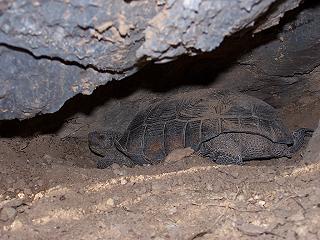
With the summer rains and cooler weather knoking on our door, we'll be out in the field with our cameras soon. Happy Trails! Walt
Posted by saffossils
at 7:42 PM MDT
Updated: Thursday, 22 September 2011 7:43 PM MDT
Saturday, 11 June 2011
Sometimes it's better to let things lay.....
We recently received an email from the Flint Hills Discover Center in Manhattan Kansas. They are setting up an exibit and requested the use of one of our website images. The only issue was that the image was taken almost 10 years ago, and the native resolution was only 1280 X 960. For most this might be a show stopper. Not for us. Since we seldom collect anything we simply took our best camera back into the field and took the image again. They seemed pleased with the results, and we're definately pleased that they chose to use our image. Sometimes it's better to let things lay. We made another excursion to the Whetstone mountains, where we looked over outcrops of Mesozoic Limestone, and Permian Colina Limestone. We found a Gastropod that seems to be the same species as a Gastropod we found in the Tucson Mountains. Here are the two images.... 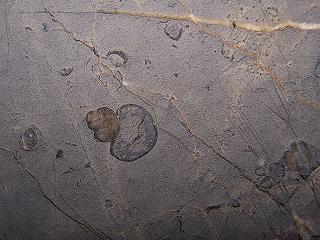
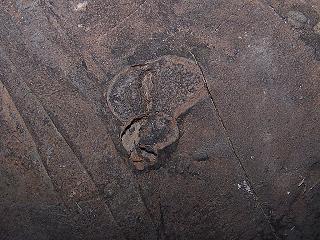 Based on that, we believe that this is actually fresh water limstone, and not equivalent to Mural Limestone. Mural limestone appears to be cropping out higher up in the section. We also looked over outcrops of Colina Limestone and photographed a nice assortment of Permian Gastropods and echinoid debris. All in all it's been a busy time here at Southern Arizona Fossils. Happy Trails, Walt
Posted by saffossils
at 7:17 PM MDT
Updated: Sunday, 26 June 2011 2:41 PM MDT
Sunday, 27 March 2011
The Waterman Mountains....
We recently did some exploration among limestone cliffs of the Waterman Mountains. The Mountains are composed of a large block of late Permian sediments tilted to the south, exposing a large block of Concha Limestone. We found a typical assemblage of late Paleozoic fauna including many gastropods. Special Note: The Waterman Mountains are located inside the Ironwood Forest National Monument, no collecting is allowed...... 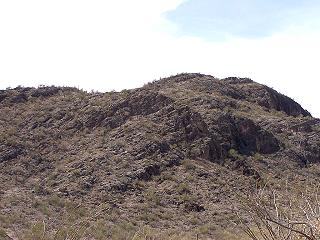
Posted by saffossils
at 8:56 PM MDT
Updated: Sunday, 27 March 2011 9:03 PM MDT
Monday, 17 January 2011
Revision Time...
Well, I predicted several months ago that if we ever got hold of a detailed map of the Canelo Hills, we would be making revisions to a few previous trips. I was right. After a few trips in the field with a detailed map, we found a few problems. There were no real serious errors, but a few images we had labled as Late Permian were actually Early Permian. A few images we labeled as Pennsylvanian, were actually Early Permian. A few images we labeled as Late Devonian were actually Mississippian. When it was all said and done, we edited just about every trip to the Sonoita area and the Canelo Hills. Having a map sure makes a difference. I think everything is in order now, but we'll probably do more editing as we make more trips into the area. On the most recent trip to the area, we photographed a few nice Ompalotrochus Gastropods. 
We also founds an interesting outcrop in the Mississippian Escabrosa Limestone containing numerous miniature Crinoid Sections which we turned into our lates virtual exploration page. 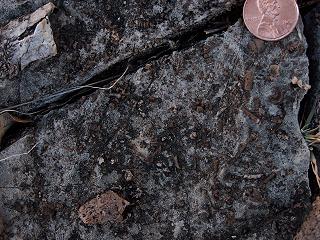
Happy Trails! Walt
Posted by saffossils
at 8:30 PM MST
Updated: Monday, 17 January 2011 8:30 PM MST
Saturday, 4 December 2010
More Paleozoic Fossils from the Canelo Hills.....
We recently had the oportunity to make a couple of trips to the Canelo Hills where we photographed a typical assemblage of Early Permian fossils including some nice Straparollus Gastropods. 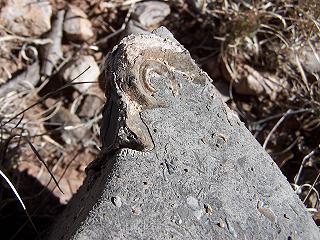
Thanks to the generosity of Dr. Karl Flessa from the U of A, we have obtained a wonderful report on the geology in the Canelo Hills. I've followed Dr Flessa's CEAM site for some time which, among other things, has monitored the impact on wildlife in the Colorado River delta from the diversion of Colorado River water. If you've not visited the site, here is a link. I've studied the Canelo Hills report in some detail now, and have some major backtracking do to on a couple of previous expeditions. Here at Southern Arizona Fossils, we're always looking for new ways to showcase Arizona's fossil wonders. We've added a new section titled Virtual Exploration. The current page was just an experiment, but we were happy enough with the results that we went ahead and put it on the site. The image and loupe may take a while to load, but once it does you should be able to drag the loupe around the image, and see a magnified view. In this case, we found a nice assemblage of Echinoid debris in the Early Permian Earp formation. If you have any issues with the page, let us know.... Happy Trails, Walt
Posted by saffossils
at 6:51 PM MST
Updated: Saturday, 4 December 2010 6:53 PM MST
Tuesday, 26 October 2010
Tucson Mountains and the one that almost got away....
Why is it that the image of the best fossil I find in any given locality turns out blurry? It must be the camera, and not my technique  . At any rate, on a recent trip to the Tucson Mountains, we encountered a 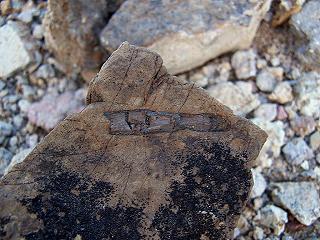 nice outcrop containing thousands of mixed broken bivavle shells. This layer can be found in several locations in the Tucson Mountains, but is seldom traceable for more than a few hundred feet. In amongst the coquinoidal limestone was a nice plant stem. I managed to get several fair images of the limestone, but all of the plant stem images were somewhat blured. I fixed the best image up as best I could and posted it here. This location is inside Tucson Mountain Park, and is a "No Collect" area. I guess I'll be forced to make another trip  . We also stopped by a local outcrop of Horquilla Limestone and photographed a typical assemblage of Pennsylvanian age invertebrates. You can see all of the images here.
Posted by saffossils
at 8:00 PM MDT
Thursday, 30 September 2010
Finally, time for an update....
I finally found the time to update the "updates" page. We recently spent some time near Parker Canyon Lake, and photographed a few nice rudists in the Mural Limestone outcrops in the huachuka mountains. These Worm Burrows are nice as well. 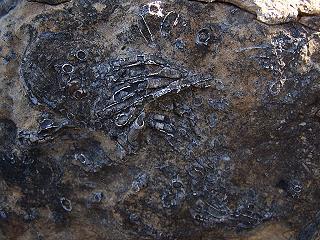 See all of the recent shots on our updates page. Happy Trails, Walt
Posted by saffossils
at 6:59 PM MDT
Updated: Friday, 1 October 2010 4:42 PM MDT
Tuesday, 31 August 2010
Oracle Trip August 2010
We recently visited the Oracle area, it has been a year or so since we were there last, and it is not too far from where we live. We were surprised to find the center of an archimedes bryozoan in the upper Mississippian deposits there. We also photographed an unknown fossil from the same outcrop, along with a typical assemblage of corals from the Dovonian Martin formation. 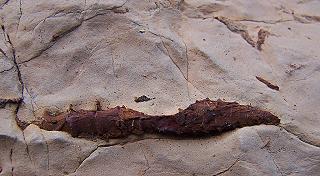 On a recent trip to the Tucson Mountains we caught a beautiful Sunset, and posted it as a wall paper. We also photographed a nice black-tailed rattlesnake, and a tarrantula.
Posted by saffossils
at 6:55 PM MDT
Updated: Tuesday, 31 August 2010 7:00 PM MDT
Saturday, 14 August 2010
Gardner Canyon Formation
On a recent trip, we set out to photograph redbeds of the Gardner Canyon formation, look for fossils, and generally get out and have a good time in the mountians. There has been a lot of rain in the Santa Rita mountains this year, and the scenery was quite spectacular. 
Although we did not find any fossils in the Gardner Canyon formation (and none have been reported to my knowledge), the green vegetation against the red rocks made for some nice photo ops. We also managed to ge a nice time lapse of storm clouds over the Santa Rita mountains. You can see that here. We have started to make some general simplified correlations on our Mesozoic formations page as we continue working on our current video project. With the August heat keeping us inside, we'll probably be udating old pages with links to high resolution images, and attempting to identify some of our previous finds. Happy Trails... Walt walt@safossils.com
Posted by saffossils
at 3:00 PM MDT
Updated: Saturday, 14 August 2010 3:31 PM MDT
Thursday, 29 July 2010
It's time we started a blog.....
I've decided to start a blog as a way to keep up with things we need to do on the site, advertise up coming trips and revisions, and identification of past finds. Our most recent trip brought us out to the Rosemont Junction area to look over outcrops of Early Cretaceous Apache Canyon formation rocks before they are buried beneath tones of mine waste rock. A recently published Map (link) of the Rosemont area gave us a few clues as to where to find outcrops. We found much of the area is private land, but we managed to find a few outcrops on forest service land. The only fossils we found were cross sections of what appeared to be Gastropods.  We did manage to get a few photos for our up coming feature video of Mesozoic rocks in Southern Arizona. We'll be spending more time in this area in the near future, as we delve more into the Jurassic and Cretaceous sediments of Southern Arizona. A recently purchased geology map of the Santa Rita Mountains has required us to revise a couple of previous expeditions. Outcrops we had identified as Concha Limestone should have been identified as the Rain Valley formation. We've never visited the "Type" area for the Rain Valley formation, and outcrops in the Tucson Mountains contain a lot of sand, and quartz blebs, so this did not look like the Rain Valley formation we are use to seeing. We'll probably have to do some more back-tracking as we continue to study the map, and visit more of the “Type” areas for different formations. If we ever get a detailed geology map of the Canelo Hills, we’ll probably have to do some more major back-tracking.
Posted by saffossils
at 6:40 PM MDT
Updated: Friday, 30 July 2010 11:44 AM MDT
Newer | Latest | Older
|
|
|








 . At any rate, on a recent trip to the Tucson Mountains, we encountered a
. At any rate, on a recent trip to the Tucson Mountains, we encountered a  nice outcrop containing thousands of mixed broken bivavle shells. This layer can be found in several locations in the Tucson Mountains, but is seldom traceable for more than a few hundred feet. In amongst the coquinoidal limestone was a nice plant stem. I managed to get several fair images of the limestone, but all of the plant stem images were somewhat blured. I fixed the best image up as best I could and posted it
nice outcrop containing thousands of mixed broken bivavle shells. This layer can be found in several locations in the Tucson Mountains, but is seldom traceable for more than a few hundred feet. In amongst the coquinoidal limestone was a nice plant stem. I managed to get several fair images of the limestone, but all of the plant stem images were somewhat blured. I fixed the best image up as best I could and posted it  . We also stopped by a local outcrop of Horquilla Limestone and photographed a typical assemblage of Pennsylvanian age invertebrates. You can see all of the images
. We also stopped by a local outcrop of Horquilla Limestone and photographed a typical assemblage of Pennsylvanian age invertebrates. You can see all of the images 


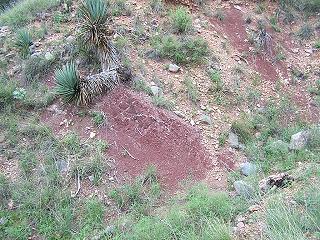
 We did manage to get a few photos for our up coming feature video of Mesozoic rocks in
We did manage to get a few photos for our up coming feature video of Mesozoic rocks in